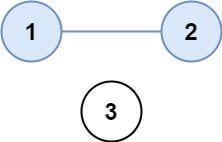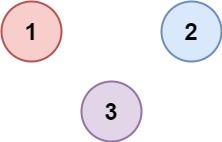There are n cities. Some of them are connected, while some are not. If city a is connected directly with city b, and city b is connected directly with city c, then city a is connected indirectly with city c.
A province is a group of directly or indirectly connected cities and no other cities outside of the group.
You are given an n x n matrix isConnected where isConnected[i][j] = 1 if the ith city and the jth city are directly connected, and isConnected[i][j] = 0 otherwise.
Return the total number of provinces.
Example 1:
Input: isConnected = [[1,1,0],[1,1,0],[0,0,1]] Output: 2
Example 2:
Input: isConnected = [[1,0,0],[0,1,0],[0,0,1]] Output: 3
Constraints:
1 <= n <= 200n == isConnected.lengthn == isConnected[i].lengthisConnected[i][j]is1or0.isConnected[i][i] == 1isConnected[i][j] == isConnected[j][i]
class Solution:
def findCircleNum(self, isConnected: List[List[int]]) -> int:
def dfs(i):
for j in range(n):
if not visited[j] and isConnected[i][j] == 1:
visited[j] = True
dfs(j)
n = len(isConnected)
visited = [False] * n
num = 0
for i in range(n):
if not visited[i]:
dfs(i)
num += 1
return numclass Solution {
public int findCircleNum(int[][] isConnected) {
int n = isConnected.length;
boolean[] visited = new boolean[n];
int num = 0;
for (int i = 0; i < n; ++i) {
if (!visited[i]) {
dfs(isConnected, visited, i, n);
++num;
}
}
return num;
}
private void dfs(int[][] isConnected, boolean[] visited, int i, int n) {
for (int j = 0; j < n; ++j) {
if (!visited[j] && isConnected[i][j] == 1) {
visited[j] = true;
dfs(isConnected, visited, j, n);
}
}
}
}

